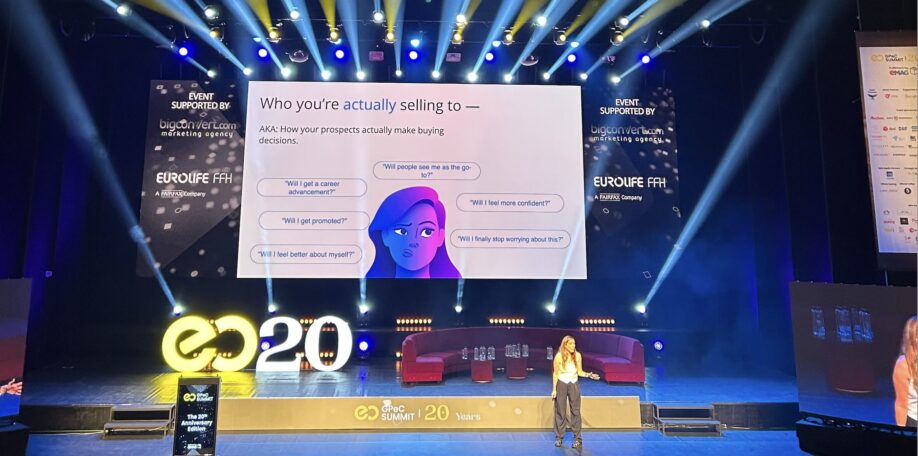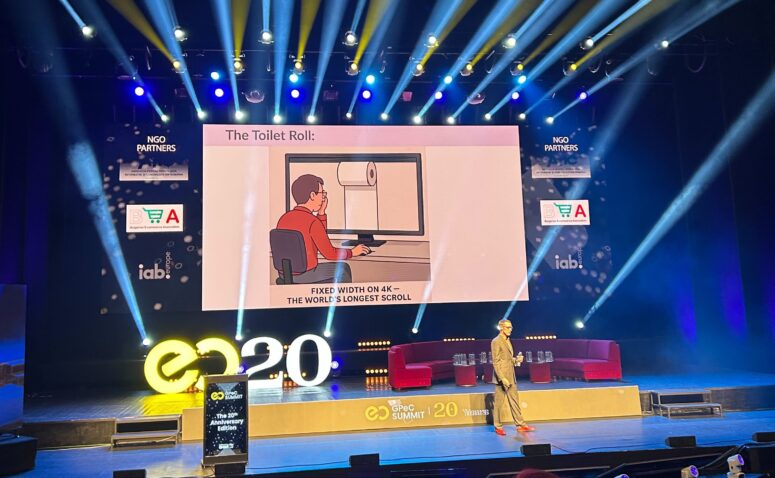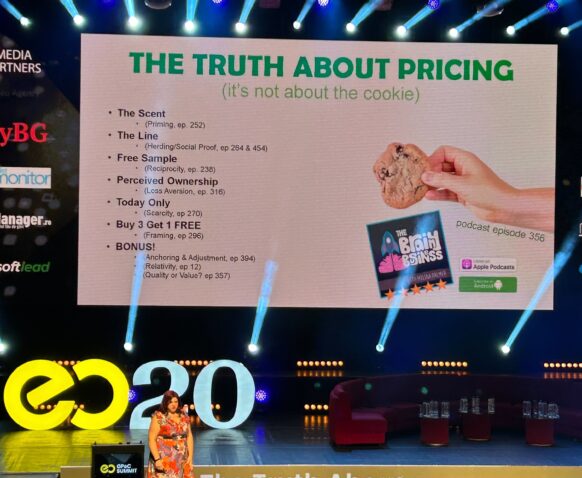 We made our way to GPeC Summit | The 20 Years Edition, one of the top spots for all things e-commerce in CEE.
We made our way to GPeC Summit | The 20 Years Edition, one of the top spots for all things e-commerce in CEE.
It’s us – Ioana, Oana & Cristina – and if you missed it… no worries.
We’re back with the highlights from the digital frontlines.🫡
The summit brought together the usual suspects: brands, marketers, innovators, all chasing what’s next in e-commerce. Two decades in, GPeC still knows how to spark conversations: about growth, data, creativity, and the humans behind the clicks. From ideas to friendly debates, it was a reminder that digital isn’t just about tech, but about people who make it matter.
Between panels, coffee breaks, and various conversations, some ideas stuck. And we want to share them with you.
Emotion before algorithms, by Talia Wolf
Talia Wolf’s talk was a sharp reminder that behind every click, form submission, or purchase sits a human brain. She challenged the standard “feature-first” approach and showed how sites that lean on meaningless demographic data, cold benefits, or price points often miss the point: humans buy with feeling first and justify with logic later.
Her “emotion first” framework turns funnels into stories that speak to what people actually care about: their fears, desires, social image, and the way a solution makes them feel. Every color, image, and word on your site isn’t decoration, but a part of the conversation with your visitor.
A few ideas that stuck:
- Every buying decision starts with emotion, not logic. Rationalization comes afterward.
 For example, think about an employee deciding which software to buy. The fear of making the “wrong” choice is real. IBM’s famous ad nailed it: “Nobody ever got fired for buying IBM.” It reassures the buyer emotionally first, then the logic follows.
For example, think about an employee deciding which software to buy. The fear of making the “wrong” choice is real. IBM’s famous ad nailed it: “Nobody ever got fired for buying IBM.” It reassures the buyer emotionally first, then the logic follows.
- Customers ask not just “Does this solve my problem?” but “How will this make me feel afterward?”
- Social image matters. Buyers care about how they’ll feel and be seen after choosing a solution.
- Meaningless data (age, location, job title, browser) is a distraction. Focus on insights that reflect real customer concerns.
- Websites should be about the customer, not your products or prices. Reflect their needs and pains at every step.
- Small emotional cues, like images, colors, UX/UI, stories, social proof, influence decisions more than features alone.
- Emotion drives conversions even in “boring” or technical products. Deep human layers exist in every purchase.
- CRO works best with a structured, customer-first approach: research → identify problem → test/experiment.
- Tactics focus on testing growth; strategy focuses on building tools; processes to implement and validate ideas.
Device experience: where customers decide if you get paid by Craig Sullivan
Craig Sullivan laid it out plain and simple: if your site or app doesn’t work flawlessly on the devices your customers actually use, you’re leaving money on the table. Forget waiting for feedback. Device experience starts in customers hands, and small gaps can quietly wreck conversions and UX. The good news? Fixing it isn’t complicated or costly. With the right tools, real devices, and targeted testing, you can turn those hidden pain points into revenue.
Ideas that stuck:
- Device experience starts in the hands of your customers: don’t wait for complaints, be proactive.
- Most errors come from a mix of fast delivery, uneven code quality, lack of QA on real devices, lack of A/B testing.
- Device optimization isn’t just tech; site copy, content, and messaging influence the perceived UX just as much.
- Just 5-7 key devices usually drive over 90% of revenue or engagement, so make sure these work flawlessly.
- Use real devices whenever possible; simulators and emulators can miss critical UX issues. Second-hand devices are fine for testing. Google Analytics holds the device, model, screen, and setup data you need to close experience gaps.\A/B testing post-launch is essential for new features. 65% of A/B tests have QA problems, often device-specific.
- UX depends on subtle details: keyboard layouts on mobile, auto-complete for addresses, and avoiding unnecessary spellcheck in forms.
- Improving device experience is one of the fastest ways to boost both revenue and user satisfaction.
Romanian e-Commerce in the first 3 trimesters of the year, forecasts for BF, Q4 & 2026, by Andrei Radu & Tudor Manea
Hearing Tudor Manea unpack the year at eMAG was like getting a peek behind the curtain of Romania’s biggest online store. He shared what worked, what didn’t, and where the company is placing its bets for Q4 and beyond. From Genius upgrades to AI experiments, credit-driven growth, and marketplace expansion across borders, the conversation made clear one truth: understanding customers and empowering sellers is the engine behind eMAG’s results.
Ideas that stuck:
- eMAG saw double-digit growth in H1, but Q3 reflected the impact of fiscal measures, higher VAT and energy costs affected sales volume.
- Genius loyalty programs drive engagement: 1M+ customers enrolled, spending 50–60% more; free delivery, priority support, extended returns, and promotions all matter.
- Black Friday remains a social event, never leaving leftover stock, and credit/BNPL options now drive the biggest sales growth.
- Out-of-home advertising and AI investments are central to future growth; testing AI agents is on the horizon.
- Cross-border expansion (Bulgaria + Hungary) is supported through dedicated marketplace programs; sellers can replicate success with local tools.
- Protecting brands and combating fake products is a priority; the Brand Portal allows sellers to safeguard their identity.
- Fashion is growing, though consumables remain the dominant category.
- Sellers should focus on customer-centric programs and discounts; these remain key drivers of loyalty and repeat purchases.
- Every operational decision, from Genius to BNPL to AI, revolves around understanding the customer and making their journey seamless.
The truth about pricing: using brain science to sell more, easier, by Melina Palmer
Melina Palmer flipped the script on pricing, proving that it’s never really about numbers. It’s about the human brain. Her session reminded us that psychology rules how customers perceive value, make decisions, and act.
Using storytelling, social proof, and clever framing, pricing can become a tool to guide behavior rather than just a tag on a product. The key takeaway? Understand what your buyer values, then design pricing and offers that speak to that, not just the cookie cutter price list.
Ideas that stuck:
- Pricing isn’t about the numbers, but about perception, emotion, and context.
- Stories shape value: our brains interpret, remember, and act based on narratives, not just facts.
- Decide whether your business focuses on value or quality, this choice drives pricing strategy.
- “It’s Not About the Cookie” framework:

- Price perception is subtle: the same amount can feel different depending on formatting. For example, USD 4.999,90 vs 4.990,90 vs 4.990 vs 5000. Oddly enough, the last one can feel smaller even if the number is technically higher.
- 70% of our sensory input comes from vision, the visuals matter in pricing presentation.
- Reciprocity is powerful: consider how you can be generous to customers to drive action.
- People hate losing what they perceive as theirs; limited offers or exclusivity taps into this bias.
- Keep messaging simple, clear, and direct; avoid complicated language.
One thing is clear: e-commerce isn’t just about platforms, funnels, or features. It’s about people and understanding how they feel, how they act, and how you can make their experience better, faster, and more human.
From emotion-first conversions to device-perfect experiences, cross-border insights, and pricing psychology, the summit reminded us that growth doesn’t come from chasing trends. It comes from thinking, testing, and designing for the humans behind every click.



